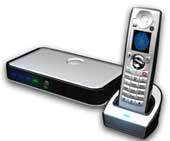U.S. Cordless Phones Finally Catch Up
Cordless-phone technology dedicated to improving sound quality is making a big splash at the International Consumer Electronic Show (CES) in Las Vegas.

Credit: Thompson
Known as Digital Enhanced Cordless Telecommunications (DECT), the digital processing and encryption scheme has been used in Europe for about a decade, but in the United States the necessary dedicated bandwidth hasn’t been available.
American cordless phones have typically used the 2.4 gigahertz and 5.8 gigahertz bandwidths, subjecting them to interference from modern appliances that also use those bandwidths, such as microwave ovens, baby monitors, Wi-Fi, and home security devices, explains Vincent Buet, product strategy and marketing manager for phones at Philips. “Thirty years ago, no one expected anything but phones to be using that spectrum,” he says.
But in 2005, the U.S. military abandoned use of the 1.9 gigahertz bandwidth, and it was dedicated to the cordless phones. “Nothing else is allowed on that band,” Buet explains. The result was the creation of a specifically American version of DECT: 6.0. (The European DECT phones use a slightly lower bandwidth.)
“DECT phones have three advantages,” says Buet. “They have good sound quality, thanks to digital processing; they have no interference; and they have long battery life.” The DECT protocol was originally designed with low power consumption in mind, and Buet boasts that the Philips units had a stand-by battery life of 150 hours and talk time of 10 to 12 hours–about double what previous technologies offered, he indicates.
Thompson came out with U.S. DECT phones in September 2006, explains Doug DeLor, a marketing director at the company. The Swiss-based DECT Forum predicted that 634,000 DECT 6.0 phones would be sold in 2006. The final figure was closer to a million, the DECT Forum recently announced, and vendors rushed to introduce new models, some of which are displayed at CES.
“DECT has taken off,” DeLor says, noting that Thompson was showing 15 new DECT 6.0 models at the show. He is particularly proud of the $179 InfoLink phone, which uses its own broadband Internet interface to display RSS news feeds. Another unit, which costs $149, can connect to a PC and synchronize with Microsoft Outlook. Other units start as low as $49. All should be on the market by June, DeLor says.
The new Philips line of DECT phones should be available by April, says Buet. The high-end model is the $179 ID 937, with a 30-minute answering machine and a SIM card reader to transfer data from GSM cell phones. Thanks to the presence of digital processing, Philips was also able to add a feature called High Def Voice to its high-end DECT units. Traditionally, a telephone only carries the sound spectrum used by the human voice (400 to 4,400 hertz), but High Def Voice fills in the harmonics above and below that range, so voices sound more natural, Buet explains.
Uniden America came out with five models of DECT 6.0 phones in the last months of 2006, says spokesperson Amanda Shannahan. She adds that the next generation, due out later this year, will let the buyer place four base units around the house, and as a cordless phone is carried through the home, it will link up with the base that offers the best connection–sort of like an in-house cell-phone network.
The basic unit is the $79 Uniden DECT 1069-2, which comes with two handsets (with a charger for the second one). The $89 DECT 1080-2 adds answering-machine features. Additional handsets cost $29.
Keep Reading
Most Popular
Large language models can do jaw-dropping things. But nobody knows exactly why.
And that's a problem. Figuring it out is one of the biggest scientific puzzles of our time and a crucial step towards controlling more powerful future models.
How scientists traced a mysterious covid case back to six toilets
When wastewater surveillance turns into a hunt for a single infected individual, the ethics get tricky.
The problem with plug-in hybrids? Their drivers.
Plug-in hybrids are often sold as a transition to EVs, but new data from Europe shows we’re still underestimating the emissions they produce.
Stay connected
Get the latest updates from
MIT Technology Review
Discover special offers, top stories, upcoming events, and more.